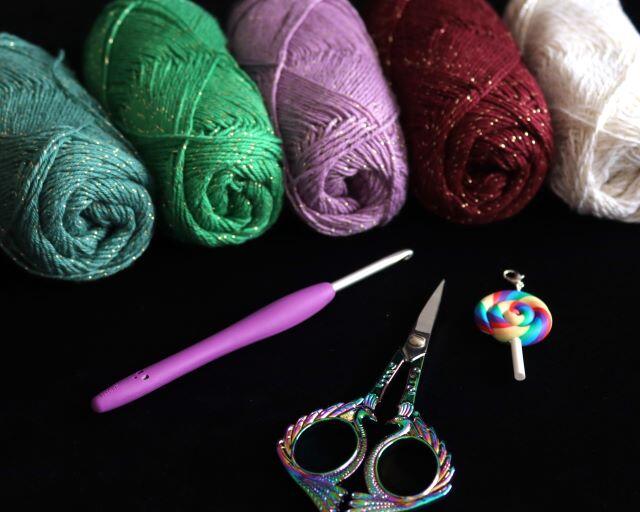Crocheting, an age-old craft, has seen a resurgence in popularity in recent years. For beginners, diving into the world of crochet can be both exciting and slightly daunting due to the plethora of patterns, stitches, and materials available. Whether you’re looking to create cozy blankets, stylish garments, or charming amigurumi, understanding the basics is essential. In this article, we’ll cover the fundamental tools required for crocheting and provide some beginner-friendly project suggestions.

Essential Crochet Tools and Materials
- Crochet Hooks: These are the primary tools used to create crochet stitches. They come in various sizes, usually indicated by a letter or number. The size of the hook you need often is dictated by the yarn you’re using and the project’s desired gauge. For beginners, a set of hooks ranging from sizes 4mm to 6mm is a good starting point. Also, check our in-depth article on the crochet hooks Best Crochet Hooks for Beginners: An Essential Guide.
- Yarn: Yarn is the mainstay of any crochet project. It comes in various fibers, weights, and colors. For beginners, it’s best to start with medium-weight yarns, such as worsted or aran. These yarns are easier to work with and are commonly used in many patterns.
- Scissors: A good pair of sharp scissors is essential for cutting yarn.
- Yarn Needle: This is a blunt needle with a large eye, useful for weaving in ends or sewing pieces together.
- Stitch Counters: To help you to keep track of progress of your work and those are essential tools with more complex crochet works. Read our article of the stitch counters: The Crochet Stitch Counter: A Crocheter’s Key to Precision.
- Patterns: While not a “tool” in the traditional sense, patterns are guides that instruct you on creating specific projects. There are countless patterns available online, in books, and in magazines. There is plenty of free patterns available – see our other article for more information.
- Blocking Board: To ensure that your projects look their best, a crochet blocking board becomes an indispensable tool. It’s not just about making the stitches; it’s about presenting them in their best form and blocking boards are essential tools for this. Read our article covering the topic in greater detail: Crochet Blocking Board: Essential Tool for Perfecting Your Craft.
- Yarn Holder: While optional, this tool will bring a lot more control into your setup. Read our article on the yarn holders: Yarn Holder Guide: Types, Pros, and Crafters’ Picks.
What to Crochet
Crocheting offers endless possibilities. From functional items to decorative pieces, the choices are vast. Some popular categories include:
- Garments: Sweaters, cardigans, tops, and dresses can all be crocheted. These are more complex and may not be ideal for beginners but can be future goals.
- Accessories: Hats, scarves, mittens, socks, and shawls are quicker projects that often require less yarn.
- Home Décor: Think blankets, cushion covers, table runners, and wall hangings. These projects add a touch of handmade warmth to any space.
- Amigurumi: These are crocheted stuffed toys or figurines. From adorable animals to fantastical creatures, amigurumi can range from simple to complex.
- Bags and Pouches: Whether it’s a stylish tote or a small coin purse, crocheted bags are both functional and fashionable.
What to Crochet for Beginners
Starting with simpler projects can help beginners get the hang of the basics without feeling overwhelmed. Here are some beginner-friendly project ideas:
- Dishcloths or Washcloths: These small squares are perfect for practicing basic stitches. They work up quickly, and you’ll have a functional item at the end.
- Scarves: A basic scarf can be as simple as crocheting a long rectangle. It’s an excellent way to practice consistency in your stitches. Check out our free crochet cowl pattern.
- Granny Squares: You can join those classic motifs can together to create blankets, bags, and more. They’re a fantastic way to learn about combining colors and stitches.
- Simple Hats: Start with a basic beanie. As you become more comfortable, you can add variations, like different stitch patterns or pompoms.
- Coasters: Small, quick, you can make them using a variety of stitch patterns.
- Headbands: A simple band crocheted in the round or as a rectangle and then joined can make a stylish accessory.
- Amigurumi Balls or Cubes: Before diving into intricate amigurumi figures, start by making basic shapes to understand the concept of crocheting in the round and increasing or decreasing stitches.
Remember, the key to successful crocheting is practice and patience. If your stitches aren’t perfect at first, don’t get discouraged. Over time, with repetition, you’ll see improvement.
Conclusion
Crocheting is a rewarding and versatile craft. With a few basic tools and materials, you can embark on a creative journey that offers endless possibilities. For beginners, it’s essential to start small and gradually tackle more complex projects as your skills and confidence grow. Whether you’re crocheting a simple dishcloth or dreaming of a detailed garment, each stitch brings you closer to creating something uniquely yours. So grab your hook and yarn, and let the crafting begin!